Предлагаемый урок является первым уроком раздела “Very traditional Britain”. Основное внимание уделяется формированию лексических навыков и речевых умений по теме. На уроке учащиеся знакомятся с правилами дорожного движения в Великобритании и сравнивают их с правилами вождения на дорогах Беларуси. Применение информационно-коммуникационных технологий способствует повышению познавательного интереса учащихся.
Наталья ИЛЬИНА,
учитель английского языка
ГУО «Средняя школа № 3 г. Ганцевичи»,
Брестская область
Тема урока: Traditions on the British roads.
Класс: 8-й.
Цель урока: формирование лексических навыков и речевых умений по теме.
Задачи:
образовательные:
– создать условия для формирования у учащихся лексических навыков по теме «Традиции на британских дорогах»;
– способствовать формированию навыков чтения и восприятия иноязычной речи на слух;
– содействовать формированию у учащихся речевых умений по теме.
развивающие:
– способствовать развитию языковой догадки;
– содействовать развитию внимания, памяти, мышления;
– создать условия для расширения кругозора учащихся.
воспитательные:
– содействовать воспитанию уважительного отношения к культуре, традициям и обычаям своей страны и страны изучаемого языка.
Прогнозируемый результат: предполагается, что к концу урока учащиеся будут знать основные традиции и правила вождения на дорогах Британии и смогут сравнить их с правилами вождения на белорусских дорогах.
Тип урока: урок изучения нового материала.
Вид урока: традиционный.
Формы работы: индивидуальная, групповая, коллективная.
Оснащение: учебное пособие для 8-го класса учреждений общего среднего образования с русским языком обучения (с электронным приложением) «Английский язык 8 класс»/ Л.М.Лапицкая [и др.] – Минск, 2021; презентация, мультиборд с доступом в интернет, аудиозапись, раздаточный материал.
Ход урока
I Организационно-мотивационный этап
Задачи этапа: создание атмосферы иноязычного общения, постановка целей урока, актуализация знаний, необходимых для изучения нового материала.
1 Приветствие
Good morning, everybody. Welcome to our English lesson! Take your seats, please. Is everyone OK today? How are you, Andrei? What about you, Lera? How are you doing,..? So, if everyone is all right and ready for the lesson, let’s get started.
2 Целеполагание
Look at the screen, please. You can see the topic of our lesson, but it’s not complete – two words are missing. (Слайд 1)
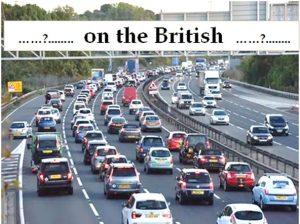
In order to get the missing words, you have to do some tasks.
Task 1. What word is missing in all the sentences? (Слайд 2)
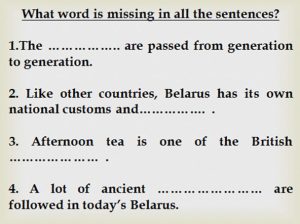
Right you are, the missing word is “traditions”.
Учащиеся читают получившиеся предложения. (Слайд 3)
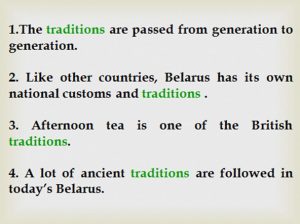
Task 2. Do the crossword to get the other word.
https://learningapps.org/view28782432
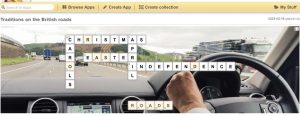
Учащиеся по очереди выходят к доске и выполняют задание на мультиборде в сервисе LearningApps.org.
This holiday is celebrated twice in our country: on the 25th of December and on the 7th of January. (Christmas)
People sing them at Christmas. (Carols)
In what month do we celebrate Fool’s Day? (April)
Belarusian people celebrate this holiday on the 3d of July. (Independence)
On what holiday do people paint eggs? (Easter)
The key word is “roads”.
And here’s the topic of our today’s lesson: “Traditions on the British roads”. (Слайд 4)
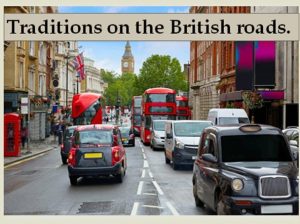
3 Речевая зарядка
As you already know, British people are very fond of their customs and traditions. What British traditions do you remember? (Boxing Day, Queen’s or King’s official Birthday, Bonfire night, a traditional roast turkey with potatoes and vegetables for Christmas, afternoon tea, trick-or-treating at Halloween).
Well done. And today you’ll learn about driving traditions in the UK.
The aims of the lesson are (таблички с целями урока вывешиваются на доске по мере того, как дети их озвучивают):
– To learn new words on the topic
– To do exercises
– To read and listen to the text about driving traditions in the UK
– To compare driving traditions in Belarus and in the UK
II Операционно-деятельностный этап
Задача этапа: организация познавательной деятельности учащихся по усвоению новых знаний.
1 Введение и первичное закрепление новой лексики
To be able to discuss the new topic, we have to learn some new words.
https://quizlet.com/765863777/traditions-on-the-british-roads-flash-cards/
Look at the pictures, listen to the words and their definitions and try to guess their Russian equivalents.

На платформе Quizlet.com новая лексика вводится с помощью флэш-карт. Сначала учащиеся прослушивают слово и его определение, которое сопровождается изображением, затем читают определение и называют слово.
– Read the definition and say the word.
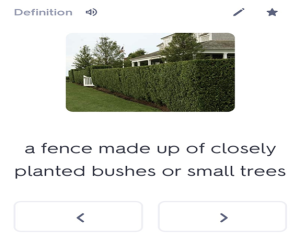
Индивидуальная работа в рабочих тетрадях.
– Unscramble the words and write them under the pictures. WB. Ex. 1, p. 26–28
2 Работа с текстом
Предтекстовый этап. Снятие языковых трудностей. Подготовка к восприятию текста
– Match the words. Translate the word combinations into Russian. (№ 1, Приложение 1)
– What would you like to know about driving traditions in Britain? Work in groups, please. Each group should think of one or two questions on the topic. Use the prompts from Ex.2, p. 146. (Дети работают в группах и составляют вопросы, на которые хотели бы получить ответы после прослушивания текста. Вопросы записываются на доске).
Текстовый этап. Прослушивание текста. Развитие навыков чтения и аудирования
Now listen and read the text and answer the questions.
Ex. 3a, p. 146 (Приложение 2)
Учащиеся слушают и читают текст, затем отвечают на поставленные ранее вопросы.
Релаксационная пауза “Pass the envelope”
Учащиеся под музыку передают конверт с заданиями по кругу. На ком музыка останавливается, тот вытягивает задание и отвечает на вопрос (Приложение 3).
Послетекстовый этап. Контроль понимания прочитанного
– Are the following statements true or false? Correct the false statements. (Слайд 5), (№ 2, Приложение 1).
1. In Britain people drive on the left-hand side of the road.
2. The steering wheel is on the left.
3. Petrol and diesel are among the cheapest in the world.
4. The wearing of seat belts is not obligatory.
5. The minimum age for driving a car in the UK is 17.
6. The minimum age for riding a moped or motorbike is 18.
7. Many of the roads are built on the old roads laid down by the Romans centuries ago.
Работа в сервисе Wordwall.net
– Spin the wheel and answer the questions.
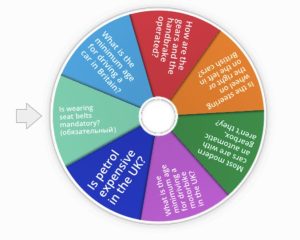
Учащиеся по очереди выходят к доске и отвечают на выпавшие вопросы.
https://wordwall.net/resource/32685925
1. What is the minimum age for driving a car in Britain?
2. How is the gear and the handbrake operated?
3. Is the steering wheel on the right or on the left in British cars?
4. What is the minimum age for driving a motorbike in the UK?
5. Is petrol expensive in the UK?
6. Is wearing seat belts mandatory?
7. Most modern cars are with an automatic gearbox, aren’t they?
Интерактивная викторина в сервисе Kahoot.com
Now, take your mobile phones and do the quiz to see how attentive you were.
Учащиеся отвечают на вопросы викторины с помощью своих мобильных телефонов. В конце игры автоматически определяются три победителя.
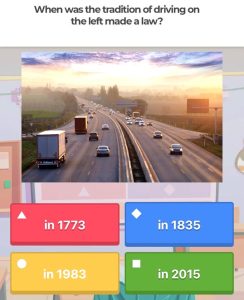
https://create.kahoot.it/share/traditions-on-the-british-roads/c6fbf888-27dc-4492-b567-9ae04adbab0f
3 Развитие навыка говорения
Сompare driving in Britain and in Belarus. (Слайд 6), (Task 3, Приложение 1).
1. In Britain people drive on the left. In Belarus we drive on the right.
2. The steering wheel is on the right in British cars.
3. The accelerator (gas pedal) is on the right.
4. The gears and almost always the handbrake (parking brake) are operated with the left hand.
5. Most modern cars in Britain are automatic.
6. All motorists must wear front seat belts in Britain. The minimum age for driving a car in the UK is 17, and 16 for riding a moped or motorbike.
III Рефлексивно-оценочный этап
Задача этапа: подведение итогов урока, выставление отметок, объяснение домашнего задания.
You’ve done a great job today. Have a look at the aims of our lesson. What have we done today? (Возвращаемся к целям урока).
– We have learnt and practiced new words
– We have done exercises
– We have read and listened to the text about driving traditions in the UK
– We have compared driving traditions in Belarus and in the UK
Now, complete the sentences, please.
I know …..
I can …..
Your task is to write information for foreign visitors to Belarus about traditions on the Belarusian roads. Open your diaries and put down your home assignment for the next lesson.
WB. Ex. 2, p. 28 Слайд 7.
Your marks are…
Thank you for you work, good bye.
Приложение 1
Handouts “Traditions on the British roads”
I. Match the words.
|
1. drive on the left-hand side |
gearbox |
|
2. go back |
limit |
|
3. to be operated |
of the road |
|
4. automatic |
centuries |
|
5. minimum |
on the left |
|
6. speed |
with the left hand |
|
7. drive |
driving age |
|
8. at a speed |
carriageway |
|
9. single |
of 35 mph |
II. Listen to the text and say if the following statements are true or false.
1. In Britain people drive on the left-hand side of the road.
2. The steering wheel is on the left.
3. Petrol and diesel are among the cheapest in the world.
4. The wearing of seat belts is not obligatory.
5. The minimum age for driving a car in the UK is 17.
6. The minimum age for riding a moped or motorbike is 18.
7.Many of the roads are built on the old roads laid down by the Romans centuries ago.
III. Compare driving in Britain and in Belarus.
1. In Britain people drive on the left. In Belarus we drive on the right.
2. The steering wheel is on the right in British cars.
3. The accelerator (gas pedal) is on the right.
4. The gears and almost always the handbrake (parking brake) are operated with the left hand.
5. Most modern cars in Britain are automatic.
6. All motorists must wear front seat belts in Britain. The minimum age for driving a car in the UK is 17, and 16 for riding a moped or motorbike.
Приложение 2
Traditions on the British roads (script)
The first thing you notice when you come to Britain is that they drive on the left-hand side of the road. Taking the left-hand side on the road is a custom or habit that goes back centuries when people used to carry swords, most often in their right hand, to protect themselves. The custom was encouraged by the General Highways Act of the British Government (1773), which advised horse riders, coachmen and people taking their vegetables to market to drive on the left. The rule was made a law by the Highway Act of 1835.
So, the second thing you notice is that the steering wheel is on the right. However, the pedals are in the same position as in left-handed cars, with the accelerator– gas pedal – on the right.
The gears and almost always the handbrake are both operated with the left hand. Less and less cars on the roads are with a manual gearbox (с ручной коробкой передач). Most modern cars are with an automatic gearbox.
Petrol and diesel are among the most expensive in the world.
The wearing of front seat belts was made mandatory (обязательное) for motorists in 1983.
The minimum age for driving a car in the UK is 17, and 16 for riding a moped or motorbike with a maximum engine capacity (мощность двигателя) of 50 cc (cubic centimeters).
There are some 225,000 miles (362,000 km) of roads in Britain. Many of the roads are built on the old roads laid down by the Romans centuries ago.
Roads in Britain range from wide modern motorways to narrow country lanes usually bordered by hedges, stone walls, grassy banks of rivers or ditches (рвы). Cities and towns tend to have compact streets because they go back to the times well before cars appeared, and were certainly not planned for large lorries.
The National Speed limits
On motorways and dual carriageways drivers can drive cars at a speed of 70 mph (112 km/h)
Single carriageway roads: 60 mph (96 km/h)
Built up areas, e.g. towns and villages: 30 mph (48 km/h)
Residential areas: 20 mph (35 km/h)
All speed limits and distances are given on signs in miles or miles per hour. One mile is about 1.6 km. Round signs indicate (указывают) speed limits with the number circled by a red band (полоса). When the speed limit is no longer applied, then there is a black line crossing through the number.
Приложение 3
“Pass the envelope”
What holiday is it?
1. This holiday is celebrated on the 1st of April. People play jokes on it. (April Fool’s Day)
2. This state holiday is celebrated on the 3d of July in Belarus. (Independence Day)
3. Pumpkin is the main symbol of this holiday. (Halloween)
4. This holiday is celebrated on the 26th of December. It’s the day after Christmas in Britain (Boxing Day)
5. People give heart-shaped chocolates and cards on this day. (St. Valentine’s Day)
6. This holiday is celebrated on the 5th of November in Britain. (Bonfire Night)
7. The main symbols of this Belarusian holiday are pancakes. (Maslenitsa)
8. On this holiday people in Belarus jump over the fire, look for the blossoming fern flower, bathe in the river and dance in karagods. (Kupalle)



 Предложить публикацию
Предложить публикацию